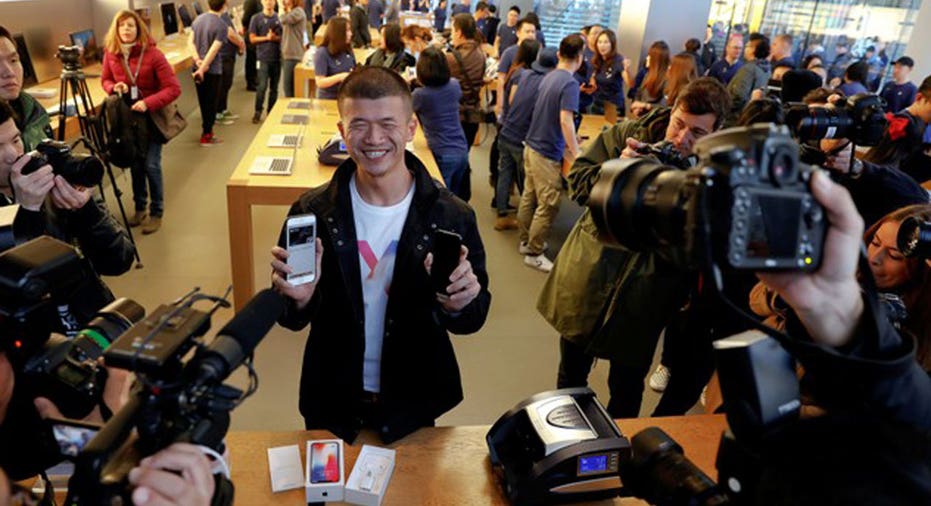Apple store lines return as iPhone X debuts

Long lines outside of Apple stores around the world showed strong initial demand for the new iPhone X, but analysts said the real test would be the company's ability to sustain that level of interest over the coming months as it works through supply bottlenecks.
Sales of the iPhone X began Friday, and hundreds of customers lined up in Australia and Singapore, aiming to be among the first in the world to get their hands on the most expensive iPhone ever, with a starting price of $999 and features including an edge-to-edge display and a facial-recognition system. It wasn't clear how many units Apple would have available for first-day sales.
At an Apple store in central Sydney, lines snaked around the corner midmorning local time, despite the store opening at 8 a.m., an hour earlier than usual, to cope with expected demand. Gav Hannelly, 25 years old, waited for an hour for a space-gray, 256-gigabyte iPhone X. Mr. Hannelly, an IT worker who says he bought almost every new iPhone as soon as it hit the shelves, said this year's model was particularly exciting.
"The screen has a totally different feel to it and also the face unlocks, I'm really keen to try that as well," Mr. Hannelly said.
Apple began offering advance orders online on Oct. 27, and shipment delays quickly grew to five to six weeks. Apple Chief Executive Tim Cook said Thursday that production of the phone is "going well" but declined to say when supplies would catch up with demand. The company projected record revenue for the current quarter, which Mr. Cook attributed partly to the iPhone X.
The iPhone X is the last in a trio of new phones this year. In September, Apple released the iPhone 8 and 8 Plus with wireless charging and a traditional home button. Mr. Cook said Thursday that forecasting demand for the devices has been challenging but noted that the two iPhone 8s have outsold other models since their release. He said he expects sales to pick up after customers have had a chance to review all three products.
"If we would have shipped all at once, that would have been our preferred scenario, obviously, but we didn't have that choice," Mr. Cook said in an interview. "What we wanted to do was communicate to customers everything at once so they could make their decision to buy now, wait and buy the X, or wait until they can go in and play with all three to decide."
Past iPhone models featuring new designs, such as the iPhone 6, benefited from what Strategy Analytics analyst Neil Mawston call the "halo effect," where tech-savvy customers buy it immediately and tout it to friends and family, triggering a second wave of purchases. But Mr. Mawston said consumers now suffer from "flagship fatigue" because most smartphones generally "look like a square rectangle these days."
The iPhone X also must overcome supply constraints that follow a series of production challenges, including an imbalance in key components. Strategy Analytics estimated iPhone X sales for the December quarter at less than 30 million units.
"The holiday season is the biggest portion of sales for Apple and the industry, and if you miss that it can be a painful miss sometimes," Mr. Mawston said. "The iPhone 8, in revenue and profit, can't make up for the iPhone X slippage."
In addition to supply constraints, investors and analysts have been eager to see how customers react to the device's $999 starting price. It is the highest-priced major smartphone on the market and costs so much that it is expected to cut into holiday sales of other products at traditional retailers, according to Morgan Stanley.
In China, Apple didn't offer walk-in sales of the iPhones but sold the device to customers with reservations as it has since 2013. About 80 customers lined up outside the Beijing Apple store on Friday morning to pick up their devices, including Tao Ran, a 37-year-old English teacher, who said the pricier device was "still affordable."
"In China, there is a tendency for people to attach attributes to this phone. It's a symbol of wealth, a symbol of high-level living standard," said Mr. Tao, who paid around 20,000 yuan (about $3,000) for two 256-gigabyte iPhone Xs.
Creative Strategies analyst Carolina Milanesi said price likely won't deter most customers, noting that about 45% of average U.S. iPhone owners now pay for their devices with monthly installment plans. For them, the iPhone X would cost $49.91 a month through Apple, about $16 more than an iPhone 8 per month and $27 more than an iPhone 7. In markets like Italy, where people tend to buy phones outright, she expects sales to be softer.
Lines at the Apple Store in Palo Alto, Calif., began forming Tuesday night when David Casarez, a 25-year-old entrepreneur, placed the first chair outside the store. By 6:30 p.m. Thursday, about 60 people had joined him.
The second person in line -- David Eaton, a 58-year-old software product manager -- said about 400 people lined up for the release of the iPhone 7 and 7 Plus a year ago, but he expected lines to be shorter this year because the phone is so expensive.
"People have been coming by and saying, 'Do you know you can order it online?'" Mr. Eaton said. "I say, 'Have you ever met people online?' It's about the experience."
--Rachel Pannett and Yoko Kubota contributed to this article.
Write to Tripp Mickle at Tripp.Mickle@wsj.com



















